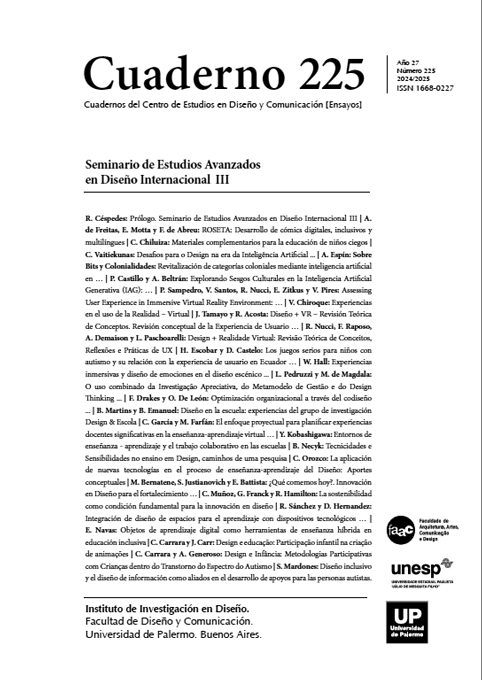Design e Infância: Metodologias Participativas com Crianças dentro do Transtorno do Espectro do Autismo
Resumen
Este artículo tiene como objetivo plantear un marco teórico acerca de las necesidades y particularidades que involucran los procesos metodológicos participativos con individuos que presentan algún tipo de discapacidad cognitiva, aquí enfocados en el Trastorno del Espectro Autista (TEA).
Citas
Carvalho, O. M. F. (2016). Do uso de jogos digitais com criança autista: Estudo de caso. Autismo: Vivências e caminhos, 77. https://pdf.blucher.com.br/openaccess/9788580391329/completo.pdf#page=78.
Deterding, S., Dixon, D., Khaled, R., & Nacke, L. (2011, September). From game design elements to gamefulness: defining” gamification”. In Proceedings of the 15th international academic MindTrek conference: Envisioning future media environments (pp. 9-15). https://journals.openedition.org/sdj/pdf/287.
Frauenberger, C., Good, J., & Keay-Bright, W. (2011). Designing technology for children with special needs: bridging perspectives through participatory design. CoDesign, 7(1), 1-28. https://www.tandfonline.com/doi/abs/10.1080/15710882.2011.587013.
Frauenberger, C., Good, J., Alcorn, A., & Pain, H. (2012). Supporting the design contributions of children with autism spectrum conditions. In Proceedings of the 11th international conference on interaction design and children e IDC’12 (vol. 134). http://dx.doi.org/10.1145/2307096.2307112.
Goh, D. H., Ang, R. P., & Tan, H. C. (2008). Strategies for designing effective psychotherapeutic gaming interventions for children and adolescents. Computers in Human Behavior, 24(5), 2217e2235. http://dx.doi.org/10.1016/j.chb.2007.10.007.
Girianelli, V. R., Tomazelli, J., Silva, C. M. F. P. D., & Fernandes, C. S. (2023). Diagnóstico precoce do autismo e outros transtornos do desenvolvimento, Brasil, 2013–2019. Revista de Saúde Pública, 57, 21.
HORN, R. E. (1998). Visual Language: Global Communication for the 21st Century. MacroVu Inc.
Lin, C. S., Chang, S. H., Liou, W. Y., & Tsai, Y. S. (2013). The development of a multimedia online language assessment tool for young children with autism. Research in developmental disabilities, 34(10), 3553-3565. https://doi.org/10.1016/j.ridd.2013.06.042.
Lira, S. M. (2004). Escolarização de alunos com transtorno autista: Histórias de sala de aula. [Dissertação de Mestrado, Universidade Estadual do Rio de Janeiro]. https://www.bdtd.uerj.br:8443/bitstream/1/10526/1/Solange%20Lira.pdf.
Mansur, O. M. F. C.; d’Oliveira P. N.. (2014) Possibilidades do uso de jogos digitais com criança autista: Estudo de Caso.In: Anais do Congresso Brasileiro de Educação Especial, São Carlos. Campinas, Galoá, 2014. https://proceedings.science/cbee/cbee6/papers/possibilidades-do-uso-de-jogos-digitais-com-crianca-autista-estudo-de-caso?lang=pt-br
Malinverni, L., Mora-Guiard, J., Padillo, V., Valero, L., Hervás, A., & Pares, N. (2017). An inclusive design approach for developing video games for children with Autism Spectrum Disorder. Computers in Human Behavior, 71, 535-549.
Mello, A. M. S. (2001). Autismo: guia prático. AMA.
Millen, L., Cobb, S.V.G., Patel, H. & Factons, H. (2011). Participatory design with children with autism. International Journal on Disability and Human Development, 10(4), 289- 294. Millen, L., Cobb, S., & Patel, H. (2011, June). A method for involving children with autism in design. In Proceedings of the 10th international conference on interaction design and children (pp. 185-188).
Millen, L., Cobb, S. V. G., Patel, H., & Factors, H. (2011). Participatory design with children with autism. International Journal on Disability and Human Development, 10(4), 289-294. Millen, L., Cobb, S., & Patel, H. (2011, June). A method for involving children with autism in design. In Proceedings of the 10th international conference on interaction design and children (pp. 185-188).
Millen, L., Edlin-White, R., & Cobb, S. (2010, March). The development of educational collaborative virtual environments for children with autism. In Proceedings of the 5th Cambridge Workshop on Universal Access and Assistive Technology, Cambridge (Vol. 1, No. 7).
NOVAK, J. (2010) Desenvolvimento de Games. Cengage Learning. Oliveira, R. O. D. (2016). Direitos humanos e autismo: entre as normativas de garantia e proteção e as políticas de inclusão da criança autista na rede pública de João Pessoa–PB. [Dissertação de Mestrado, Universidade Federal da Paraíba]. https://repositorio.ufpb.br/jspui/bitstream/123456789/11816/1/Arquivototal.pdf.
Papoutsi, C., Drigas, A., & Skianis, C. (2018). Mobile Applications to Improve Emotional Intelligence in Autism-A Review. International Journal of Interactive Mobile Technologies, 12(6). Papoutsi, C., Drigas, A., & Skianis, C. (2018). Mobile Applications to Improve Emotional Intelligence in Autism-A Review. International Journal of Interactive Mobile Technologies, 12(6).
Parés, N., Carreras, A., Durany, J., Ferrer, J., Freixa, P., Gómez, D., ... & Sanjurjo, À. (2006). Starting research in interaction design with visuals for low-functioning children in the autistic spectrum: A protocol. Cyberpsychology & Behavior, 9(2), 218-223. https://repositori.upf.edu/bitstream/handle/10230/25984/pares_cyberpsychology_starting.pdf?sequence=1.
Prensky, M. (2003). Digital game-based learning. Computers in Entertainment, 1(1), 21. http://dx.doi.org/10.1145/950566.950596.
Putnam, C., & Chong, L. (2008, October). Software and technologies designed for people with autism: what do users want?. In Proceedings of the 10th international ACM SIGACCESS conference on Computers and accessibility (pp. 3-10). https://citeseerx.ist.psu.edu/document?repid=rep1&type=pdf&doi=bce9cbb9d135f76b1c222bb4c5a5e18b209ce542.
Resnick, M. (2002). Rethinking learning in the digital age. In G. Kirkman (Ed.), The global information technology report: readiness for the networked world (pp.32 -37). Oxford University Press. http://livernspleen.com/wp-content/uploads/2012/12/readiness-forthe-networked-world.pdf#page=48
Rutter, M. L. (2011). Progress in understanding autism: 2007–2010. Journal of autism and developmental disorders, 41, 395-404. https://alut.org.il/wp-content/uploads/2013/07/Progress-in-Understanding-Autism-2007-2010.pdf.
Schwenck, C., & Freitag, C. M. (2014). Differentiation between attention-deficit/hyperactivity disorder and autism spectrum disorder by the social communication questionnaire. ADHD Attention Deficit and Hyperactivity Disorders, 6, 221-229. https://link.springer.com/article/10.1007/s12402-014-0147-9.
Tartaro, A., & Cassell, J. (2006, August). Authorable virtual peers for autism spectrum disorders. In Proceedings of the Combined workshop on Language-Enabled Educational Technology and Development and Evaluation for Robust Spoken Dialogue Systems at the 17th European Conference on Artificial Intellegence (Vol. 28). http://cs.union.edu/~cassa/tartaroa/pdfs/Tartaro2006_AuthorableVirtualPeersForAutismSpectrumDisorders.pdf.
Wehmeyer, M. L., Palmer, S. B., Smith, S. J., Davies, D. K., & Stock, S. (2008). The efficacy of technology use by people with intellectual disability: A single-subject design meta-analysis. Journal of Special Education Technology, 23(3), 21-30. https://www.academia.edu/download/56173795/Using_Video_Modeling_to_Increase_Variation_in_the_.pdf#page=23.
Wojciechowski, A., & Al-Musawi, R. (2017). Assisstive technology application for enhancing social and language skills of young children with autism. Multimedia Tools and Applications, 76, 5419-5439. https://link.springer.com/article/10.1007/s11042-016-3995-9.
Los autores/as que publiquen en esta revista ceden los derechos de autor y de publicación a "Cuadernos del Centro de Estudios de Diseño y Comunicación", Aceptando el registro de su trabajo bajo una licencia de atribución de Creative Commons, que permite a terceros utilizar lo publicado siempre que de el crédito pertinente a los autores y a esta revista.


